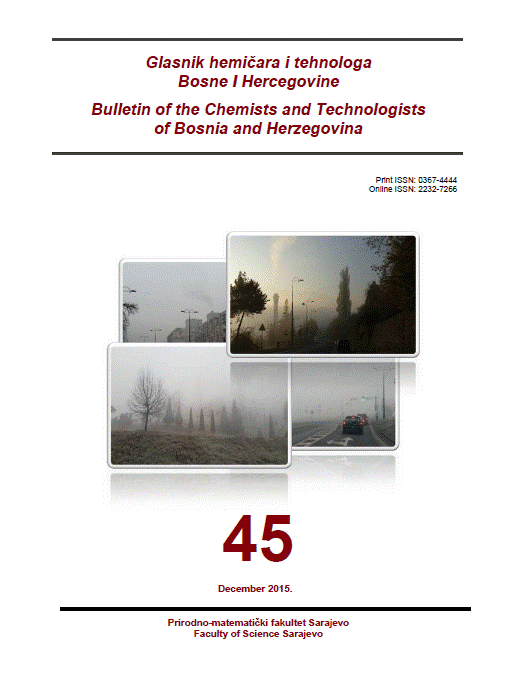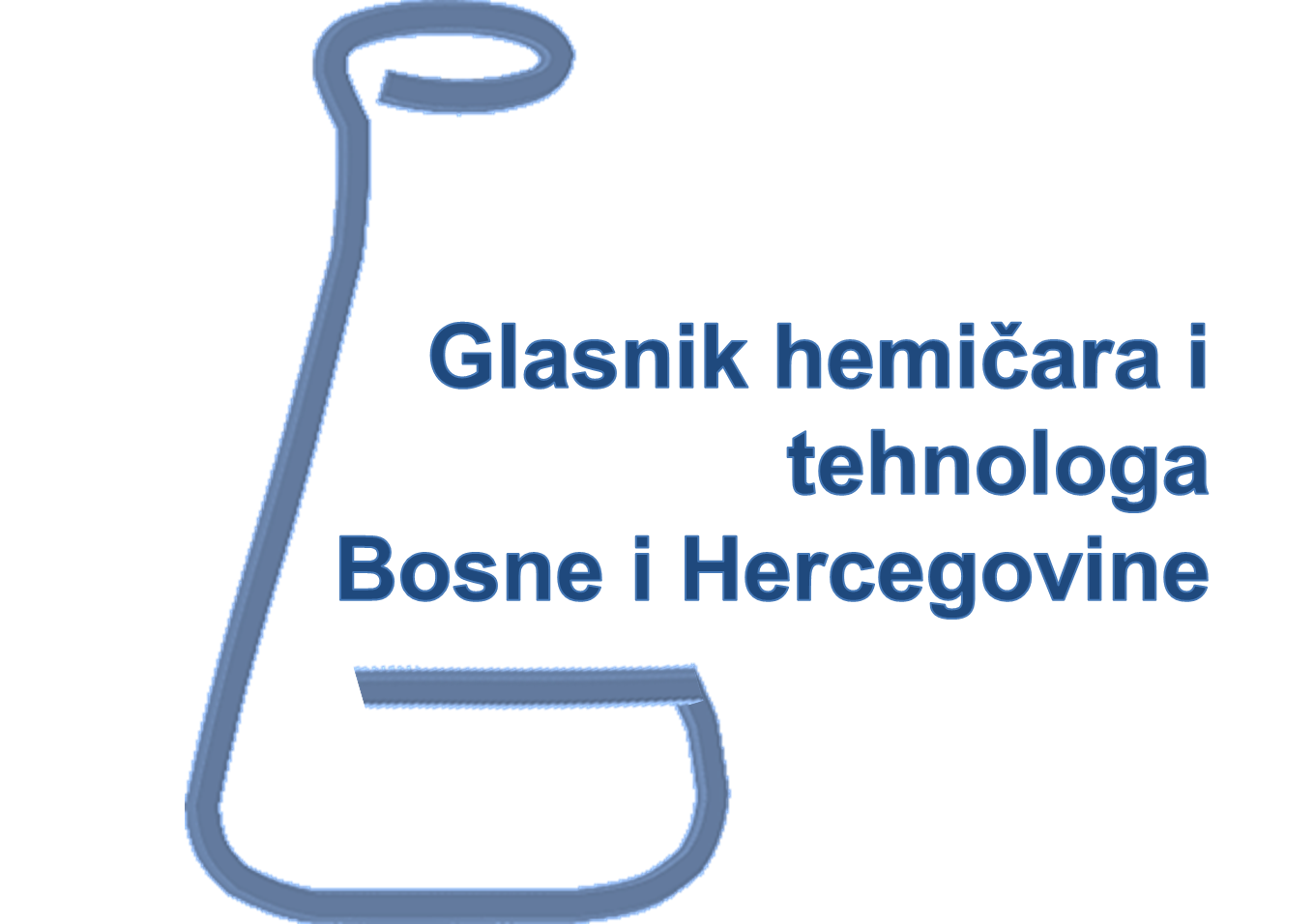|
|
Bulletin of the Chemists and Technologists of Bosnia and Herzegovina
Issue 45
Publication date: December 2015 |
Table of contents
Bis(iminato)ruthenates(III): Correlation of Half-wave Potential and Hydrolysis Constant with Electronic Effects of Substituent Original Scientific Article
Zahirović Adnan, Turkušić Emir, Kahrović Emira
Abstract: Influence of electronic effects of substituent on Schiff base ligands, derived from salicylaldehyde and 5-substituted salicylaldehydes with 2-aminophenole, on half-wave potential and hydrolysis constants of Sodium bis(iminato)ruthenates(III)hemitriethylamine solvate was investigated by cyclic voltammetry and electronic spectroscopy. New complex, Sodium bis[N-(2-oxy-κO-phenyl)salicylideneimine-κ2N,O(1-)]ruthenate(III) hemitriethylamine solvate was prepared and characterized on the basis of infrared and electron spectroscopy, MALDI-TOF/TOF mass spectrometry and ruthenium content. Cyclic voltammograms of complexes in organic solvents demonstrate quasi-reversible one-electron process with pronounced reducing power of Ru(II). Appling Hammet equation for half-wave potential of complexes we found that substituents conduct electronic density via X-C6H3-O-Ru-O-C6H3-X bonds. Electron spectroscopy was used to investigate behavior of complexes under physiological conditions and showed that hydrolysis occur. Constants of hydrolysis were determined spectrophotometrically using kinetics of pseudo-first order.
Bulletin of the Chemists and Technologists of Bosnia and Herzegovina 45, 1-8.
Antioxidant potential of selected traditional plant-based beverages in Bosnia and Herzegovina Original Scientific Article
Marjanović Aleksandra, Đeđibegović Jasmina, Brčaninović Maida, Omeragić Elma, Čaklovica Faruk, Dobrača Amila, Šober Miroslav
Abstract: The main aim of our work was to determine antioxidant capacity of some traditional non-alcoholic beverages in Bosnia and Herzegovina. Eight samples of traditionally prepared beverages were tested by DPPH and FRAP assay. Total phenolic content was determined by Folin-Ciocalteau method and anthocyanidines by Vanilin-HCl method. Total phenolic content was in range of 74.31 mg TEA/L (elder juice with lemon) to 3 365.35 mg TEA/L (pomegranate juice). Anthocyanidines content ranged from 125.27 mg/L (elder juice without lemon) to 1899.08 mg/L (traditionally prepared blackberry juice). Pomegranate juice exhibited the strongest activity against DPPH radicals (75.29% inhibition). The DPPH determined antioxidant capacity showed positive correlation with total phenolic content as well as with flavonoids content. FRAP assay showedstronger antioxidant capacity for most of the samples, compared to ascorbic acid standard. The analyzed traditionally prepared beverages showed strong antioxidant capacity which was even more pronounced than in the commercial juice.
Bulletin of the Chemists and Technologists of Bosnia and Herzegovina 45, 9-12.
Full text PDFImpact analysis of Brijesnica landfill site on the water system in the Majevica canal Original Scientific Article
Avdić Nurudin, Goletić Šefket, Šerifović Edin, Nuhanović Mirza
Abstract: The work presents the results of an investigation on an interaction between Brijesnica landfill site and ground and surface waters in the landfill site zone. Landfill site Brijesnica is located between the 44 °N Latitude and 19 °E Longitude touching the flat Semberija region and a slightly hilly area under Mt. Majevica. The seepage of the leachate water from the landfill into the ground and surface waters and their characterization was examined on a range of samples of ground and surface waters in the landfill zone. The dominating type of ground and surface water during the examination was Ca-HCO3, Mg-HCO3 and Ca-Mg-HCO3 with Ca-HCO3-NH3 being recorded at the periphery of the landfill site. A somewhat larger amount of ammonium has been recorded at the periphery of the landfill site and in the ground and surface waters in comparison with other samples. Microbiological contamination was noted alongside the landfill site and in the ground and surface waters.
Bulletin of the Chemists and Technologists of Bosnia and Herzegovina 45, 13-18.
Solid state synthesis and characterization of LiFePO4/C as cathode material for Li-ion batteries Original Scientific Article
Karaman Nejra, Aliefendić Meho, Pljuco Saša, Kozlica Dževad, Nalić Nađa, Korać Fehim, Gutić Sanjin
Abstract: Lithium transition metal phosphates have been recognized as potential positive electrodes for use in large scale production of lithium ion batteries, specially due to high thermal and chemical stability. Amongst all positive electrode materials, such as Li3V2(PO4)3, LiMnPO4 LiVPO4F, the olivine LiFePO4 has the most promising characteristics. The LiFePO4/C composite was synthesized by solid state reaction using LiOH as source of lithium ion, stearic acid which acts as reductive agent and carbon source and FePO4 precursor prepared from FeSO4×7H2O and NH4H2PO4. The starting materials were mixed in stoichiometric ratio and heated at 700°C under N2 flow to form the composite LiFePO4/C. Properties of synthesized material were analyzed by Raman spectroscopy, cyclic voltammetry (CV) and electrochemical impedance spectroscopy (EIS). Raman spectral analysis indicated some amorphous sp3 bonded carbon, sp2 graphite like phase and presence of carbides. Cyclic voltammograms confirmed good reversibility of intercalation and deintercalation of lithium ions from structure. Impedance response of the cells consisted of a depressed semicircle in the high frequency region, which is attributed to the charge-transfer process and sloping line in low frequency region which corresponds to the Warburg impedance.
Bulletin of the Chemists and Technologists of Bosnia and Herzegovina 45, 19-22.
Chemical composition and antioxidant activity of three Lamiaceae species from Bosnia and Herzegovina Original Scientific Article
Odak Ilijana, Talić Stanislava, Martinovć Bevanda Anita
Abstract: The components of essential oils of rosemary, sage and lavender were investigated by GC-MS and assayed for their antioxidant activities. The plants were collected after the end of the vegetative cycle. The principal components of sage essential oil were 1,8-cineole (28.03%), a-thujone (11.98%), veridiflorol (11.17%), and a-humulene (11.0%). Rosemary essential oil was mainly composed of a-pinene (14.02%), camphor (13.62%), 1,8-cineole (13.02%), borneol (12.45%), and berbenone (10.04%). Predominant compounds in lavender essential oil were 1,8-cineole (40.68%) and camphor (29.82%). Antioxidant activity was examined by two different methods: the 2,2'-diphenyl-1-picrylhydrazyl (DPPH) radical scavenging method and determination of ferric reducing antioxidant power (FRAP). The results indicate that the tested essential oils have low antioxidant activity compared to synthetic antioxidant butylated hydroxytoluene (BHT). In relation to the other oils investigated, rosemary essential oil showed the highest antioxidant activity by both methods.
Bulletin of the Chemists and Technologists of Bosnia and Herzegovina 45, 23-30.
Determination of gross alpha and beta activity and uranium isotope content in commercially available, bottled,natural spring waters Original Scientific Article
Nuhanović Mirza, Mulić Mirela, Mujezinović Aida, Grgić Željka, Bajić Irma
Abstract: Determination of content (active concentration) of radio-nuclides has recently become an indispensable part of the study dealing with the protection of the environment. Uranium concentration levels in aquatic environment are of great importance for environmental and safety assessmentand for the protection of public health. Achieving this purpose, monitoring program for this radio-nuclide, radium and thorium, as well as gross alpha and beta activities, seems necessary and it is applied in many countries. This study determined the activity concentration of uranium isotopes in 10 samples of drinking water, natural spring and mineral water (bottled, commercially available water). Also, gross alpha and beta activity has been determined for all samples. Activity concentration of uranium isotopes was measured with alpha-spectrometry, while gross alpha-beta activity was measured by low level gas-flow proportional alpha-beta counter. Results of the research show that the concentration of isotopic uranium activities in the tested samples of drinking water varies from 10-8to 10-2 Bq/L, while gross alpha-beta activity is between 10-3 and 10-1 Bq/g.The results show that the analyzed brands of spring, commercially available bottled waters meet the defined criteria of radiological safety.
Bulletin of the Chemists and Technologists of Bosnia and Herzegovina 45, 31-34.
Graphite, Graphite Oxide, Graphene Oxide, and Reduced Graphene Oxide as Active Materials for Electrochemical Double Layer Capacitors: A comparative Study Original Scientific Article
Kozlica Dževad, Korać Fehim, Gutić Sanjin
Abstract: In this paper report we compare the properties and the performance of four different carbonaceous materials, namely graphite, graphite oxide, graphene oxide and reduced graphene oxide, as active materials for electrochemical double layer capacitors (EDLCs). Compared to ordinary graphite, and graphite oxide, rGO have superior capacitive behavior and power output in EDLCs due to their unique nanoporous structure, porosity and enormous BET surface area close to 1200 m2g-1. The electrochemical properties of these carbonaceous materials were determined by cyclic voltammetry. The result of this investigations indicate reduced graphene oxide as a very promissing candidate for the realization of high performance EDLCs, able to display high energy and high power. In the potential range of (0 to -0.8) V, rGO has the specific capacitance of 85.9 Fg-1 in 1 molL-1 LiNO3 solution using three-electrode system. A further analysis of the electrochemical behavior in different electrolytic aqueous media showed that in Li+ solution rGO have the highest capacitance, as we compareto Na+ and K+ solutions.
Bulletin of the Chemists and Technologists of Bosnia and Herzegovina 45, 35-38.
Determination of metal contents in various chocolate samples Original Scientific Article
Alagić Nerma, Huremović Jasna
Abstract: Seven metals (Mn, Cu, Zn, Cd, Cr, Fe, and Pb) were determined in 17 different samples of chocolate and commonly consumed cocoa products using atomic absorption spectrometry, flame technique (F-AAS). Samples were prepared by wet digestion with concentrated nitric acid. Concentrations of metals (Mn, Fe, Cu and Zn), with exception of Cr, Pb and Cd, were found to be the highest in cocoa powder and black chocolate with a high content of cocoa. Concentrations of Cu, Cd and Pb were found to be below permissible levels prescribed by national Regulation of maximum permitted quantities of certain contaminants in food B&H in all samples.
Bulletin of the Chemists and Technologists of Bosnia and Herzegovina 45, 39-42.
Application of Web-based Learning Material for Teaching States of Matter in 8th Grade Primary School Chemistry – A Pilot Study Results Original Scientific Article
Nuić Ines, Glažar Saša Aleksej
Abstract: This paper presents results of a pilot study that investigated the progression in primary school students’ conceptions of the structure and states of matter while learning with a new instructional approach dealing with these concepts. The study begun in May and was continued in September 2013. In the first part of the study we included 108 7th grade students (aged 12-13) from two primary schools, and in the second part we continued the study with57 8th grade students (aged 13-14) from one school. Web-based learning material was applied as instructional tool during teaching of Structure of matter and States of matter, containing both macro and sub-micro level of representation. Students were asked to fulfill tests of knowledge dealing with macroscopic and submicroscopic level of representation. Results showed better understanding of structure and states of matter but also some persistent misconceptions that could be addressed in the following period.
Bulletin of the Chemists and Technologists of Bosnia and Herzegovina 45, 43-50.
Interpretation of results obtained from test purification of wastewater with zinc electrodes Original Scientific Article
Halilović Namir, Gutić Sanjin, Korać Fehim, Avdić Nurudin
Abstract: Basic materials used for electrochemical purification of wastewater are iron and aluminium electrodes. In this paper, results obtained from analysis of wastewater samples before and after electrolysis with zinc electrodes are presented and compared with the results of aluminium electrodes and mixed metal oxide electrodes. In all experiments with zinc, the same materials were used as anode and cathode. After 7 min of electrolysis at only 0,018 A/dm2, concentration of chloride in was reduced using zinc electrodes, and the efficiency of microorganisms removal is double, directly and indirectly. The effects of the main parameters in electrochemical cell with zinc electrodes – changes in the conductivity of the solution, variation of pH, turbidity of samples, removal of chloride and production of hypochlorous acid were investigated.
Bulletin of the Chemists and Technologists of Bosnia and Herzegovina 45, 51-56.





